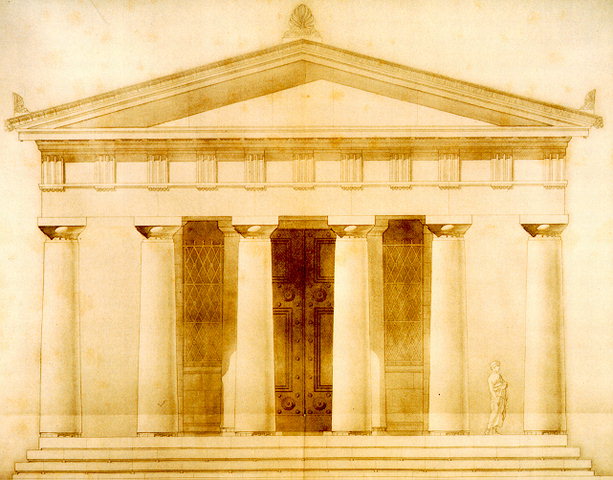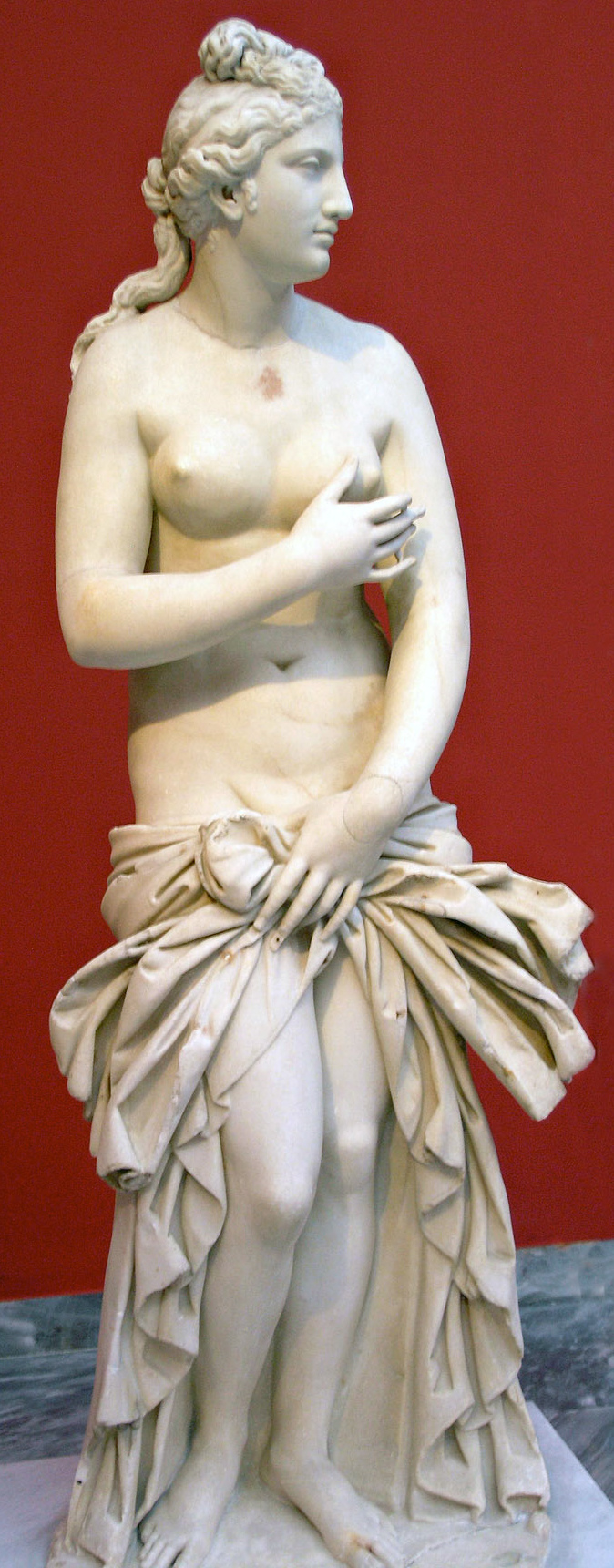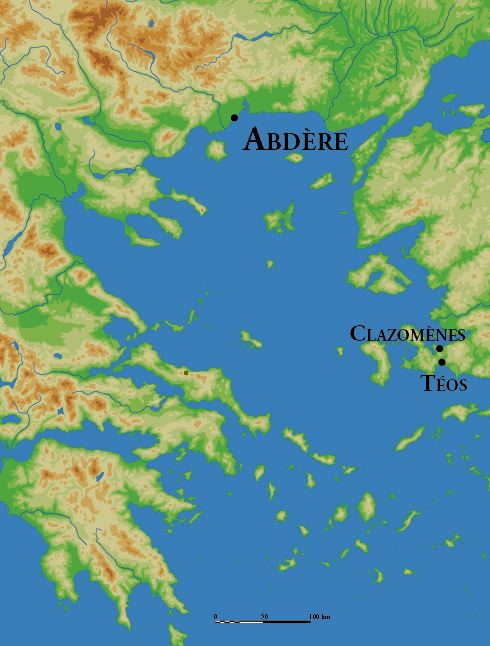|
Darrhon
Darrhon or Darron (Greek: Δάῤῥων) was a Paeonian god of healing, whose cult was adopted by the ancient Macedonians, as mentioned by Hesychius as Macedonian Daemon and attested hapax in one inscription of Pella c. 200-150 BC. Excavations revealed a sanctuary of Darrhon in ancient Pella. It has been argued that while Darrhon (Greek:Δάῤῥων) was initially a minor deity, he was later identified and worshiped as Asclepius. Etymology It has been suggested that "Darrhon" is a Macedonian-styled name of Greek participle θαρρῶν tharrhon, meaning "giving courage, making bold". Θάρρων, ''Tharrhon'', is an Eretrian eponym. Alternatively, his name might be derived from the Thracian tribe of Derrones in the north part of the Strymon valley, compare Apollo Derenus in Abdera Pindar's Paeans: A Reading of the Fragments with a Survey of the Genrby Ian Rutherford See also * Apollo * Eileithyia * Hygeia * Panacea In Greek mythology, Panacea (Greek ''Πανάκε� ... [...More Info...] [...Related Items...] OR: [Wikipedia] [Google] [Baidu] |
Apollo
Apollo, grc, Ἀπόλλωνος, Apóllōnos, label=genitive , ; , grc-dor, Ἀπέλλων, Apéllōn, ; grc, Ἀπείλων, Apeílōn, label=Arcadocypriot Greek, ; grc-aeo, Ἄπλουν, Áploun, la, Apollō, la, Apollinis, label=genitive, , ; , is one of the Twelve Olympians, Olympian deities in Ancient Greek religion, classical Greek and Ancient Roman religion, Roman religion and Greek mythology, Greek and Roman mythology. The national divinity of the Greeks, Apollo has been recognized as a god of archery, music and dance, truth and prophecy, healing and diseases, the Sun and light, poetry, and more. One of the most important and complex of the Greek gods, he is the son of Zeus and Leto, and the twin brother of Artemis, goddess of the hunt. Seen as the most beautiful god and the ideal of the ''kouros'' (ephebe, or a beardless, athletic youth), Apollo is considered to be the most Greek of all the gods. Apollo is known in Greek-influenced Etruscan mythology as ' ... [...More Info...] [...Related Items...] OR: [Wikipedia] [Google] [Baidu] |
Greek Gods
The following is a list of gods, goddesses, and many other divine and semi-divine figures from ancient Greek mythology and ancient Greek religion. Immortals The Greeks created images of their deities for many purposes. A temple would house the statue of a god or goddess, or multiple deities, and might be decorated with relief scenes depicting myths. Divine images were common on coins. Drinking cups and other vessels were painted with scenes from Greek myths. Major gods and goddesses Greek primordial deities Titans and Titanesses The Titan gods and goddesses are depicted in Greek art less commonly than the Olympians. File:Eos Memnon Louvre G115.jpg, Eos (Dawn) and the hero Memnon (490–480 BC) File:Ilion---metopa.jpg, Helios in his four-horse chariot (3rd century BC) File:0029MAN-Themis.jpg, Themis, from the Temple of Nemesis (ca. 300 BC) File:Antakya Arkeoloji Muzesi 02366 nevit.jpg, Oceanus wearing crab-claw horns, with Tethys ( Roman-era mosaic) File:Creation Promet ... [...More Info...] [...Related Items...] OR: [Wikipedia] [Google] [Baidu] |
Asclepius
Asclepius (; grc-gre, Ἀσκληπιός ''Asklēpiós'' ; la, Aesculapius) is a hero and god of medicine in ancient Greek religion and mythology. He is the son of Apollo and Coronis, or Arsinoe, or of Apollo alone. Asclepius represents the healing aspect of the medical arts; his daughters, the "Asclepiades", are: Hygieia ("Health, Healthiness"), Iaso (from ἴασις "healing, recovering, recuperation", the goddess of recuperation from illness), Aceso (from ἄκεσις "healing", the goddess of the healing process), Aegle (the goddess of good health) and Panacea (the goddess of universal remedy). He has several sons as well. He was associated with the Roman/Etruscan god Vediovis and the Egyptian Imhotep. He shared with Apollo the epithet ''Paean'' ("the Healer"). The rod of Asclepius, a snake-entwined staff, (similar to the caduceus) remains a symbol of medicine today. Those physicians and attendants who served this god were known as the Therapeutae of Asclepius. ... [...More Info...] [...Related Items...] OR: [Wikipedia] [Google] [Baidu] |
Strymon (river)
The Struma or Strymónas ( bg, Струма ; el, Στρυμόνας ; tr, (Struma) Karasu , 'black water') is a river in Bulgaria and Greece. Its ancient name was Strymṓn (Greek: Στρυμών ). Its drainage area is , of which in Bulgaria, in Greece and the remaining in North Macedonia and Serbia. It takes its source from the Vitosha Mountain in Bulgaria, runs first westward, then southward, forming a number of gorges, enters Greek territory at the Kula village. In Greece it is the main waterway feeding and exiting from Lake Kerkini, a significant centre for migratory wildfowl. The river flows into the Strymonian Gulf in Aegean Sea, near Amphipolis in the Serres regional unit. The river's length is (of which in Bulgaria, making it the country's fifth-longest and one of the longest rivers that run solely in the interior of the Balkans. Parts of the river valley belong to a Bulgarian (Pirin Macedonia) coal-producing area, more significant in the past than nowadays; t ... [...More Info...] [...Related Items...] OR: [Wikipedia] [Google] [Baidu] |
Religion In Ancient Macedonia
Religion is usually defined as a social-cultural system of designated behaviors and practices, morals, beliefs, worldviews, texts, sanctified places, prophecies, ethics, or organizations, that generally relates humanity to supernatural, transcendental, and spiritual elements; however, there is no scholarly consensus over what precisely constitutes a religion. Different religions may or may not contain various elements ranging from the divine, sacred things, faith,Tillich, P. (1957) ''Dynamics of faith''. Harper Perennial; (p. 1). a supernatural being or supernatural beings or "some sort of ultimacy and transcendence that will provide norms and power for the rest of life". Religious practices may include rituals, sermons, commemoration or veneration (of deities or saints), sacrifices, festivals, feasts, trances, initiations, funerary services, matrimonial services, meditation, prayer, music, art, dance, public service, or other aspects of human culture. Religions have ... [...More Info...] [...Related Items...] OR: [Wikipedia] [Google] [Baidu] |
Panacea
In Greek mythology, Panacea (Greek ''Πανάκεια'', Panakeia), a goddess of universal remedy, was the daughter of Asclepius and Epione. Panacea and her four sisters each performed a facet of Apollo's art: * Panacea (the goddess of universal health) * Hygieia ("Hygiene", the goddess/personification of health, cleanliness, and sanitation) * Iaso (the goddess of recuperation from illness) * Aceso (the goddess of the healing process) * Aglæa/Ægle (the goddess of beauty, splendor, glory, magnificence, and adornment) Panacea also had four brothers: * Podaleirus, one of the two kings of Tricca, who was skilled in diagnostics * Machaon, the other king of Tricca, who was a master surgeon (these two took part in the Trojan War until Machaon was killed by Penthesilea, queen of the Amazons) * Telesphoros, who devoted his life to serving Asclepius * Aratus, Panacea's half-brother, a Greek hero and the patron/liberator of Sicyon However, portrayals of the family were not ... [...More Info...] [...Related Items...] OR: [Wikipedia] [Google] [Baidu] |
Hygeia
Hygieia is a goddess from Greek, as well as Roman, mythology (also referred to as: Hygiea or Hygeia; ; grc, Ὑγιεία or , la, Hygēa or ). Hygieia is a goddess of health ( el, ὑγίεια – ''hugieia''), cleanliness and hygiene. Her name is the source for the word "hygiene". Hygieia is related to the Greek god of medicine, Asclepius, who is the son of the Olympian god Apollo. Hygieia is most commonly referred to as a daughter of Asclepius and his wife Epione. Hygieia and her four sisters each performed a facet of Apollo's art: Hygieia (health, cleanliness, and sanitation); Panacea (universal remedy); Iaso (recuperation from illness); Aceso (the healing process); and Aglaïa (beauty, splendor, glory, magnificence, and adornment). The role of Hygieia in antiquity One notable reference regarding Hygieia's role as a goddess of health can be found within the Hippocratic oath. This oath is used by physicians in order to swear before various healing gods, one of wh ... [...More Info...] [...Related Items...] OR: [Wikipedia] [Google] [Baidu] |
Eileithyia
Eileithyia or Ilithyiae or Ilithyia (; grc-gre, Εἰλείθυια; (''Eleuthyia'') in Crete, also (''Eleuthia'') or (''Elysia'') in Laconia and Messene, and (''Eleuthō'') in literature)Nilsson Vol I, p. 313 was the Greek goddess of childbirth and midwifery, and the daughter of Zeus and Hera. In the cave of Amnisos (Crete) she was related with the annual birth of the divine child, and her cult is connected with ''Enesidaon'' (the earth shaker), who was the chthonic aspect of the god Poseidon. It is possible that her cult is related with the cult of Eleusis. In his ''Seventh Nemean Ode'', Pindar refers to her as the maid to or seated beside the Moirai (Fates) and responsible for the creation of offspring. Her son was Sosipolis, who was worshiped at Elis. Etymology The earliest form of the name is the Mycenaean Greek , ''e-re-u-ti-ja'', written in the Linear B syllabic script. Ilithyia is the latinisation of '. The etymology of the name is uncertain, but debate ... [...More Info...] [...Related Items...] OR: [Wikipedia] [Google] [Baidu] |
Abdera, Thrace
Abdera () is a municipality in the Xanthi regional unit of Thrace, Greece. In classical antiquity, it was a major Greek ''polis'' on the Thracian coast. The ancient polis is to be distinguished from the municipality, which was named in its honor. The polis lay 17 km east-northeast of the mouth of the Nestos River, almost directly opposite the island of Thasos. It was a colony placed in previously unsettled Thracian territory, not then a part of Hellas, during the age of Greek colonization. The city that developed from it became of major importance in ancient Greece. After the 4th centuryAD it declined, contracted to its acropolis, and was abandoned, never to be reoccupied except by archaeologists. Meanwhile, life went on as the changing population settled in other communities in the region. One named Polystylus changed its name to Abdera. In 2011 the municipality of Abdera was synoecized from three previous municipalities comprising a number of modern settlements. The anc ... [...More Info...] [...Related Items...] OR: [Wikipedia] [Google] [Baidu] |
Ancient Greek
Ancient Greek includes the forms of the Greek language used in ancient Greece and the ancient world from around 1500 BC to 300 BC. It is often roughly divided into the following periods: Mycenaean Greek (), Dark Ages (), the Archaic period (), and the Classical period (). Ancient Greek was the language of Homer and of fifth-century Athenian historians, playwrights, and philosophers. It has contributed many words to English vocabulary and has been a standard subject of study in educational institutions of the Western world since the Renaissance. This article primarily contains information about the Epic and Classical periods of the language. From the Hellenistic period (), Ancient Greek was followed by Koine Greek, which is regarded as a separate historical stage, although its earliest form closely resembles Attic Greek and its latest form approaches Medieval Greek. There were several regional dialects of Ancient Greek, of which Attic Greek developed into Koi ... [...More Info...] [...Related Items...] OR: [Wikipedia] [Google] [Baidu] |
Thracian
The Thracians (; grc, Θρᾷκες ''Thrāikes''; la, Thraci) were an Indo-European speaking people who inhabited large parts of Eastern and Southeastern Europe in ancient history.. "The Thracians were an Indo-European people who occupied the area between northern Greece, southern Russia, and north-western Turkey. They shared the same language and culture... There may have been as many as a million Thracians, diveded among up to 40 tribes." Thracians resided mainly in the Balkans (mostly modern day Bulgaria, Turkey and Greece) but were also located in Anatolia (Asia Minor) and other locations in Eastern Europe. The exact origin of Thracians is unknown, but it is believed that proto-Thracians descended from a purported mixture of Proto-Indo-Europeans and Early European Farmers, arriving from the rest of Asia and Africa through the Asia Minor (Anatolia). The proto-Thracian culture developed into the Dacian, Getae, and several other smaller Thracian cultures. Thracian ... [...More Info...] [...Related Items...] OR: [Wikipedia] [Google] [Baidu] |
Paeonia (kingdom)
In antiquity, Paeonia or Paionia ( grc, Παιονία, Paionía) was the land and kingdom of the Paeonians or Paionians ( grc, Παίονες, Paíones). The exact original boundaries of Paeonia, like the early history of its inhabitants, are obscure, but it is known that it roughly corresponds to most of present-day North Macedonia and north-central parts of Greek Macedonia (i.e. probably the Greek municipalities of Paionia Evropos.html" ;"title="xcluding the village of Evropos">xcluding the village of Evropos Almopia, Sintiki, Irakleia, Serres, Irakleia, and Serres), and a small part of south-western Bulgaria. Ancient authors placed it south of Kingdom of Dardania, Dardania (an area corresponding to modern-day Kosovo and northern North Macedonia), west of the Thracian mountains, and east of the southernmost Illyrians. It was separated from Dardania by the mountains through which the Vardar river passes from the field of Scupi (modern Skopje) to the valley of Bylazora (ne ... [...More Info...] [...Related Items...] OR: [Wikipedia] [Google] [Baidu] |





.jpg)

